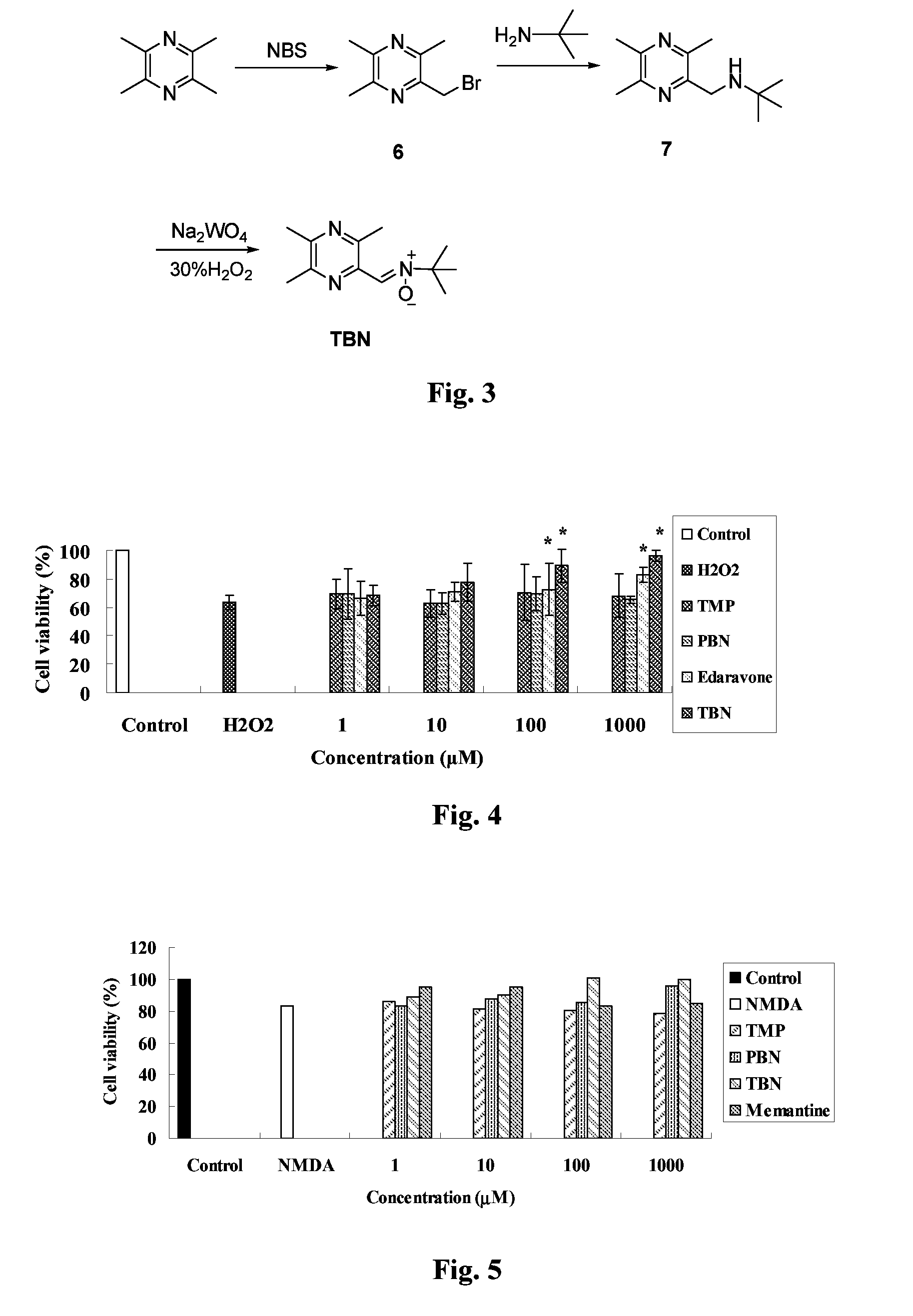Nitrone compounds, process of preparation thereof, and use thereof in medicament manufacture
- Summary
- Abstract
- Description
- Claims
- Application Information
AI Technical Summary
Benefits of technology
Problems solved by technology
Method used
Image
Examples
example 1
Synthesis of TBN (FIG. 2)
[0069]2-[[(1,1-Dimethylethyl)oxidoimino]methyl]-3,5,6-trimethylpyrazine (TBN). To aldehyde 5 (1.9 g, 0.013 mol) in methanol (200 mL) was added tert-butylhydroxylamine (1 g, 0.011 mol), and the solution was refluxed for 2 h. Another portion of tert-butyl hydroxylamine (1 g, 0.011 mol) was then added, and the solution refluxed until aldehyde 5 was completely reacted. Solvent was removed in vacuo, and the product was extracted. The solution was dried with Na2SO4, and solvent removed in vacuo. The product was purified by column chromatography, eluting with ethyl acetate / petroleum ether (1 / 1, v / v), to produce TBN as a light yellow solid (1.1 g, 38% yield), mp: 68-70° C. 1H NMR (CDCl3, ppm): 7.82 (s, 1H), 2.47 (s, 3H), 2.50 (s, 3H), 2.52 (s, 3H), 1.63 (s, 9H). ESI-MS: 222 [M+H]+, 244 [M+Na]+. Anal. (C12H19N3O) C, H, N.
example 2
Synthesis of TBN (FIG. 3)
[0070]To compound 7 (1.0 g, 0.005 mol) in methanol (100 mL) was added Na2WO4.2H2O (0.4 g) and 30% H2O2 (2.5 mL), and the reaction mixture was stirred at room temperature for 2 h. The product was filtered, and solvent removed in vacuo. To the residue was added saturated Na2S2O3 solution (8 mL). The product was extracted with ethyl acetate (25 mL×3), and the solution was dried with Na2SO4. Solvent was removed in vacuo, and the product was purified by column chromatography, eluting with ethyl acetate / petroleum ether (1 / 1, v / v), to produce TBN as a light yellow solid (0.4 g, 36% yield).
example 3
Protection of Neuronal Cells from Oxidative Damage by TBN
[0071]Cortical neurons (9×104 cells / well) were placed into 96-well cell culture plates, and were incubated at 37° C. for 24 h under 5% CO2. The medium was changed, and the cells were incubated for another 12 h. Drugs at different concentrations were added, and the cells were incubated at 37° C. for 30 min. Hydrogen peroxide were then added, and the cells were incubated for 24 h at 37° C. for 24 h under 5% CO2. A solution of 3-(4,5-dimethylthiazol-2-ly)-2,5-diphenyl-tetrazoliun bromide (MTT) was added, and the cells were incubated for another 4 h before DMSO was added. After the crystals were completely dissolved (30 min), the absorbance was read at 570 nm with a spectrophotometer (Bio-Rad Model 680, Japan). The results were expressed as the percentage of the control (saline group).
[0072]As shown in FIG. 4, TBN is more effective than either TMP or PBN in protecting cortical neuronal cells from H2O2-induced damage. TBN was appro...
PUM
| Property | Measurement | Unit |
|---|---|---|
| Structure | aaaaa | aaaaa |
Abstract
Description
Claims
Application Information
 Login to View More
Login to View More - R&D
- Intellectual Property
- Life Sciences
- Materials
- Tech Scout
- Unparalleled Data Quality
- Higher Quality Content
- 60% Fewer Hallucinations
Browse by: Latest US Patents, China's latest patents, Technical Efficacy Thesaurus, Application Domain, Technology Topic, Popular Technical Reports.
© 2025 PatSnap. All rights reserved.Legal|Privacy policy|Modern Slavery Act Transparency Statement|Sitemap|About US| Contact US: help@patsnap.com



